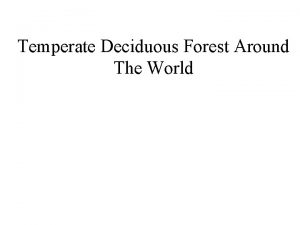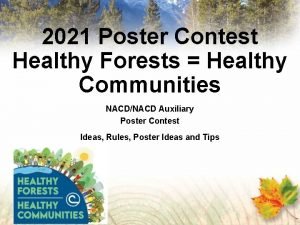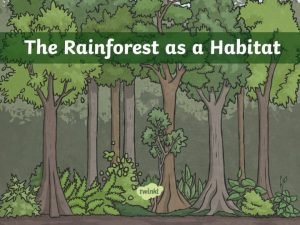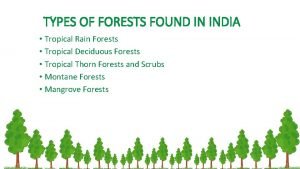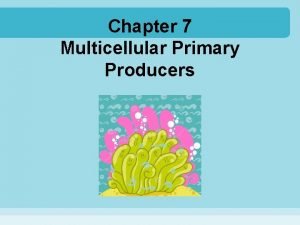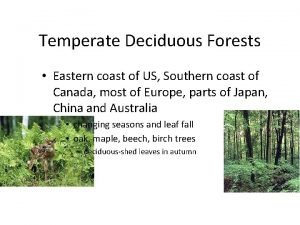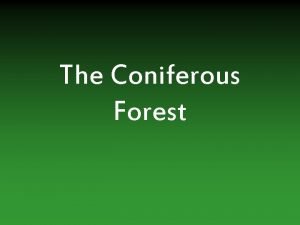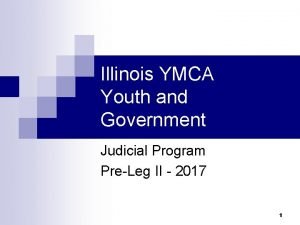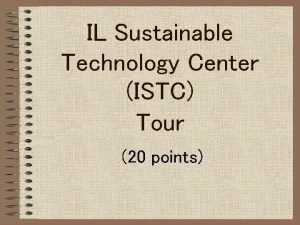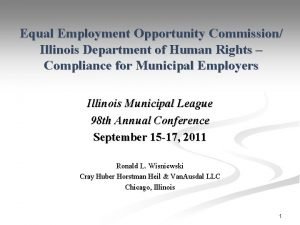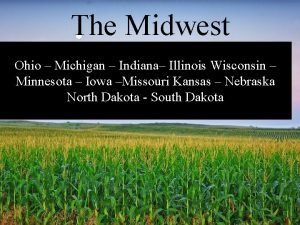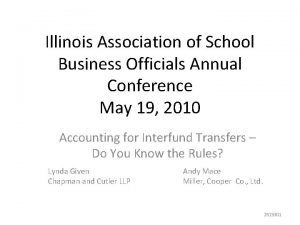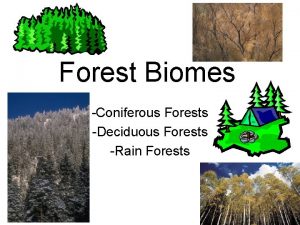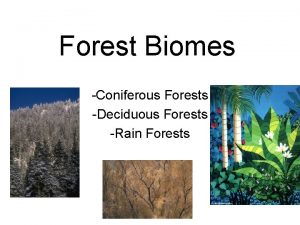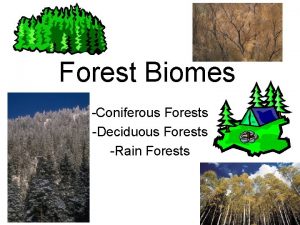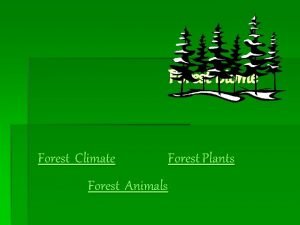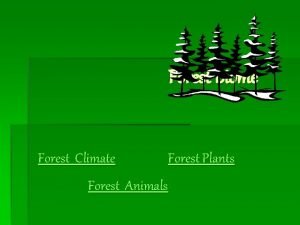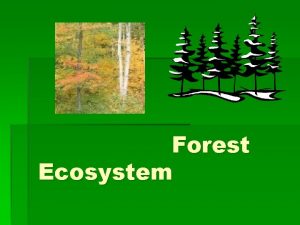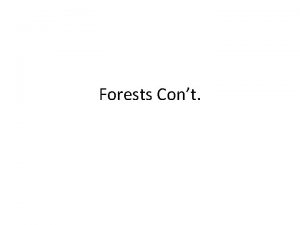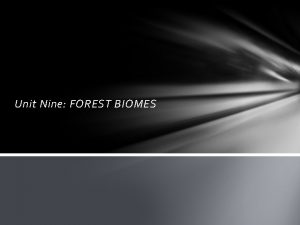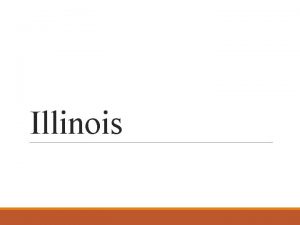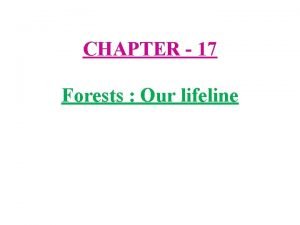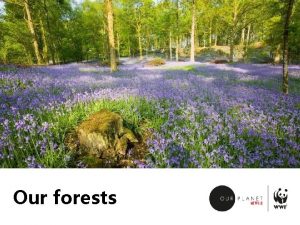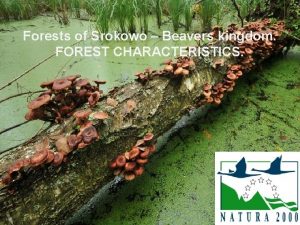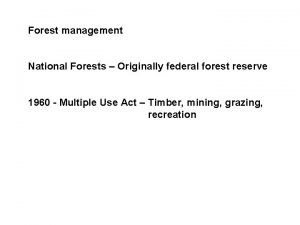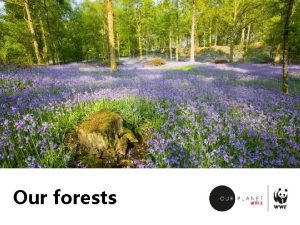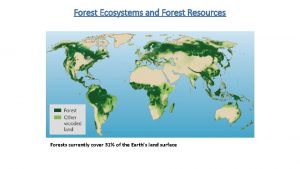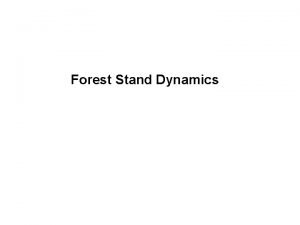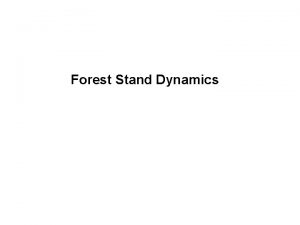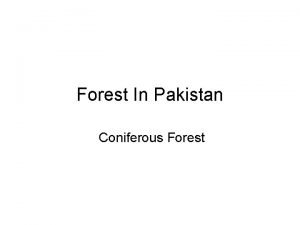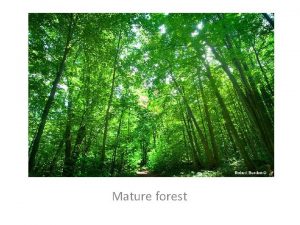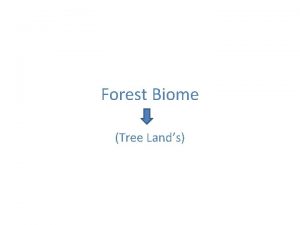Forest In Illinois Forests Forests are usually defined
































- Slides: 32

Forest In Illinois

Forests • Forests are usually defined as areas with relatively dense and extensive growth of woody plants which are at least 20 feet (6 m) in height growing closely together; • It is usually possible to distinguish layers of vegetation below the top canopy of dominant (overstorey) trees; the layers include understorey trees, lianas (woody vines), shrubs and herbaceous ground-layer vegetation

Temperate Deciduous Forest Layers



Change in Forest Acreage • In 1820, an estimated 38% of Illinois, some 13. 8 million acres, was forest. • Within a century only slightly more than 8% of this original forest remained and today only 11, 600 acres, or 0. 9%, of the presettlement forest is left. • Most forest in Illinois today (4. 27 million acres) is second or third growth



Beall Woods

Illinois Woodlots

Illinois Woodlots • Only 11% of the 214 Grade A and B forest sites cataloged by the Illinois Nature Areas Inventory are greater than 100 acres in size. • Each of the more than 169, 000 private forest owners is estimated to hold only 21. 5 acres on average. • An analysis of 13 counties in south central Illinois found that the vast majority of forests in the region were smaller than one acre in size – the equivalent of a large backyard with trees.


Animal Diversity and Forest Area • Deer and squirrels increased – like edge habitat and woods near fields • Bobcats – decreased; wolves and cougar – gone but may come back • Songbirds – species diversity high but numbers of individuals are down

Illinois Forest Birds



Southern Catalpa

Forest Communities in Illinois • Illinois's major woodland types have been described according to forest community composition and are often named for the pre-dominant overstorey trees present • These forest communities recur predictably under certain soil moisture conditions and in specific physiographic areas • Most forests in Illinois can be placed in one of six communities: oak-hickory, maple-beech, elm-ash-soft maple, oak-gum-cypress, oak-pine, loblolly-shortleaf pine, white-red-jack pine

Oak Hickory Forest

Oak-Hickory Forest • This forest is generally found on dry upland sites and south and west facing slopes - found throughout Illinois • In southeastern and eastern part of state, large numbers of species are present - white oak, black oak, post oak, shingle oak, chinkapin oak, bur oak, blackjack oak, northern pin oak, shagbark hickory, white ash, black cherry, quaking aspen, bigtooth aspen • Away from eastern Illinois, fewer species are found in the overstorey - typically white oak, red oak, bur oak and shagbark hickory in west-central Illinois • Understorey trees may include ironwood, chokecherry, hackberry, red mulberry, serviceberry, American and slippery elms, and saplings of the overstorey trees

Maple-Beech Forest

Maple-Beech Forest • Mesic upland forests grow throughout the state on hilly or sloping areas that are protected from fire. They occur on moderately moist soils through which water moves slowly but does not saturate the soil for significant periods of time. Soil nutrient content is high. Funk's Grove, in central Illinois is an example of a mesic upland forest. • Dominant trees of mesic forests include red oak, sugar maple, and beech. • Other characteristic trees include a variety of oaks, several species of hickory, slippery elm, basswood, paw, hackberry, white ash, and blue ash.

Elm-Ash-Soft Maple Forest

Elm-Ash-Soft Maple Forest • Floodplain forests occur along streams and rivers in Illinois. These forests range from relatively well drained (mesic), to poorly drained (wet), and are flooded for varying periods of time each year. The most common floodplain forest type in Illinois is the wet-mesic floodplain forest. • Characteristic trees are silver maple, elm, and ash, with no clearly dominant tree type. Flooding usually occurs in the spring, but can occur into the early summer months.

Oak-Gum-Cypress Forest

Oak-Gum-Cypress Forest • True swamps in Illinois are dominated by bald cypress and/or tupelo gum trees and are restricted in their distribution to the southern portion of the state. • Some of the trees like willows restrict roots to the upper layers of soil, which will be better aerated (contain more oxygen). • Many of the woody plants in the floodplain have welldeveloped lenticels (small holes in the bark), in addition to stomata in leaves. Oxygen from the atmosphere can be transported to the roots through these lenticels. • Others, such as bald cypress, black gum, and ash develop oxidized root zones.

Oak-Pine Forest

Oak-Pine Forest • Moderately dry sandy soils in the central and southern part of the state support oakpine forests –red oak, white pine and loblolly pine

Loblolly-Shortleaf Pine Forest

Loblolly-Shortleaf Pine Forest • More southern, drier sites support loblollyshortleaf pine forests dominated by Loblolly and Shortleaf Pine

Red-White-Jack Pine Forest

Red-White-Jack Pine Forest • More northern Illinois counties with dry sandy soils support pine forests dominated by white pine, red pine, and jack pine
 Mikael ferm
Mikael ferm Collection of well defined object
Collection of well defined object Temperate forest average precipitation
Temperate forest average precipitation Snakes in the deciduous forest
Snakes in the deciduous forest Healthy community poster
Healthy community poster Forests
Forests Very dense warm and wet forest
Very dense warm and wet forest Define coniferous forest
Define coniferous forest 12 forest of vrindavan
12 forest of vrindavan Which type of forests are found in india
Which type of forests are found in india Tropical thorn forests and scrubs
Tropical thorn forests and scrubs Materials or substances such as minerals forests
Materials or substances such as minerals forests Multicellular producers
Multicellular producers Forests reach their greatest ecological complexity when
Forests reach their greatest ecological complexity when Characteristics of temperate deciduous forest
Characteristics of temperate deciduous forest Coniferous forest weather
Coniferous forest weather Skill related fitness
Skill related fitness Illinois youth and government
Illinois youth and government Illinois digital preservation
Illinois digital preservation Kevin suitor illinois
Kevin suitor illinois Ymca texas youth and government
Ymca texas youth and government Illinois trp
Illinois trp Illinois sustainable technology center
Illinois sustainable technology center Equal opportunity illinois
Equal opportunity illinois Mycil.org illinois
Mycil.org illinois Ccr&r illinois calculator
Ccr&r illinois calculator Wabash v illinois
Wabash v illinois Illinois department of rehabilitation
Illinois department of rehabilitation Abe illinois
Abe illinois Midwest region
Midwest region Láminas del test itpa
Láminas del test itpa Illinois association of school business officials
Illinois association of school business officials Teacher leader endorsement illinois
Teacher leader endorsement illinois


